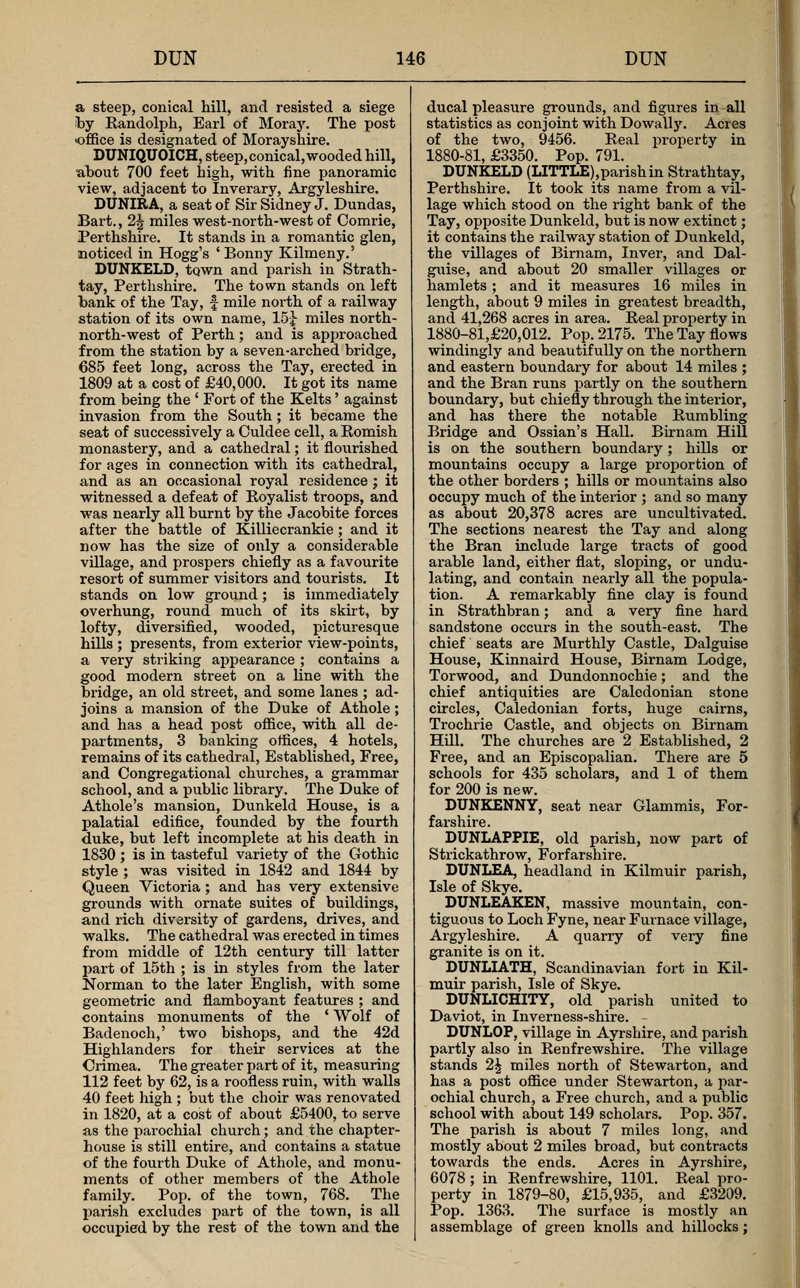DUNIQUOICH, steep,conical,wooded hill, about 700 feet high, with fine panoramic view, adjacent to Inverary, Argyleshire.
DUNIRA, a seat of Sir Sidney J. Dundas, Bart., 2i miles west-north-west of Comrie, Perthshire. It stands in a romantic glen, noticed in Hogg's ' Bonny Kilmeny.'
DUNKELD, tqwn and parish in Strathtay, Perthshire. The town stands on left bank of the Tay, f mile north of a railway station of its own name, 15 miles north-north-west of Perth; and is approached from the station by a seven-arched bridge, 685 feet long, across the Tay, erected in 1809 at a cost of 40,000. It got its name from being the ' Fort of the Kelts ' against invasion from the South ; it became the seat of successively a Culdee cell, a Romish monastery, and a cathedral ; it flourished for ages in connection with its cathedral, and as an occasional royal residence ; it witnessed a defeat of Royalist troops, and was nearly all burnt by the Jacobite forces after the battle of Killiecrankie ; and it now has the size of only a considerable village, and prospers chiefly as a favourite resort of summer visitors and tourists. It stands on low ground ; is immediately overhung, round much of its skirt, by lofty, diversified, wooded, picturesque hills ; presents, from exterior view-points, a very striking appearance ; contains a good modern street on a line with the bridge, an old street, and some lanes ; ad-joins a mansion of the Duke of Athole ; and has a head post office, with all departments, 3 banking offices, 4 hotels, remains of its cathedral, Established, Free, and Congregational churches, a grammar school, and a public library. The Duke of Athole's mansion, Dunkeld House, is a palatial edifice, founded by the fourth duke, but left incomplete at his death in 1830 ; is in tasteful variety of the Gothic style ; was visited in 1842 and 1844 by Queen Victoria ; and has very extensive grounds with ornate suites of buildings, and rich diversity of gardens, drives, and walks. The cathedral was erected in times from middle of 12th century till latter part of 15th ; is in styles from the later Norman to the later English, with some geometric and flamboyant features ; and contains monuments of the ' Wolf of Badenoch,' two bishops, and the 42d Highlanders for their services at the Crimea. The greater part of it, measuring 112 feet by 62, is a roofless ruin, with walls 40 feet high ; but the choir was renovated in 1820, at a cost of about 5400, to serve as the parochial church ; and the chapter-house is still entire, and contains a statue of the fourth Duke of Athole, and monuments of other members of the Athole family. Pop. of the town, 768. The parish excludes part of the town, is all occupied by the rest of the town and the ducal pleasure grounds, and figures in all statistics as conjoint with Dowally. Acres of the two, 9456. Real property in 1880-81, 3350. Pop. 791.
DUNKELD (LITTLE), parish in Strathtay, Perthshire. It took its name from a village which stood on the right bank of the Tay, opposite Dunkeld, but is now extinct ; it contains the railway station of Dunkeld, the villages of Birnam, Inver, and Dai-guise, and about 20 smaller villages or hamlets ; and it measures 16 miles in length, about 9 miles in greatest breadth, and 41,268 acres in area. Real property in 1880-81,20,012. Pop. 2175. The Tay flows windingly and beautifully on the northern and eastern boundary for about 14 miles ; and the Bran runs partly on the southern boundary, but chiefly through the interior, and has there the notable Rumbling Bridge and Ossian's Hall. Birnam Hill is on the southern boundary ; hills or mountains occupy a large proportion of the other borders ; hills or mountains also occupy much of the interior ; and so many as about 20,378 acres are uncultivated. The sections nearest the Tay and along the Bran include large tracts of good arable land, either flat, sloping, or undulating, and contain nearly all the population. A remarkably fine clay is found in Strathbran ; and a very fine hard sandstone occurs in the south-east. The chief seats are Murthly Castle, Dalguise House, Kinnaird House, Birnam Lodge, Torwood, and Dundonnochie ; and the chief antiquities are Caledonian stone circles, Caledonian forts, huge cairns, Trochrie Castle, and objects on Birnam Hill. The churches are 2 Established, 2 Free, and an Episcopalian. There are 5 schools for 435 scholars, and 1 of them for 200 is new.
DUNKENNY, seat near Glammis, Forfarshire.
DUNLAPPIE, old parish, now part of Strickathrow, Forfarshire.
DUNLEA, headland in Kilmuir parish, Isle of Skye.
DUNLEAKEN, massive mountain, contiguous to Loch Fyne, near Furnace village, Argyleshire. A quarry of very fine granite is on it.
DUNLIATH, Scandinavian fort in Kilmuir parish, Isle of Skye.
DUNLICHITY, old parish united to Daviot, in Inverness-shire.
DUNLOP, village in Ayrshire, and parish partly also in Renfrewshire. The village stands 2^ miles north of Stewarton, and has a post office under Stewarton, a parochial church, a Free church, and a public school with about 149 scholars. Pop. 357. The parish is about 7 miles long, and mostly about 2 miles broad, but contracts towards the ends. Acres in Ayrshire, 6078 ; in Renfrewshire, 1101. Real property in 1879-80, 15,935, and 3209. Pop. 1363. The surface is mostly an assemblage of green knolls and hillocks ; lies everywhere higher than 300 feet above sea-level, yet nowhere higher than about 150 feet above the beds of the local streams ; and commands, from many a point, an extensive panoramic view. The dairy draws chief attention of the cultivators, and has long been famous for its cheese. Dunlop House is the principal residence, and Aiket Castle the chief antiquity.

